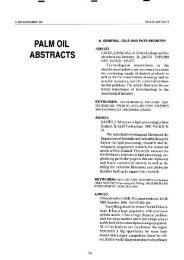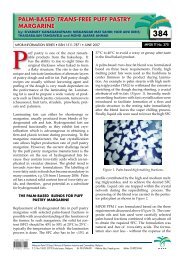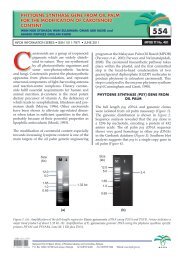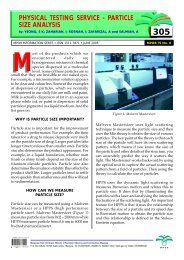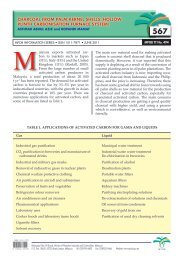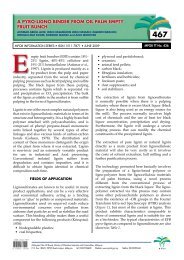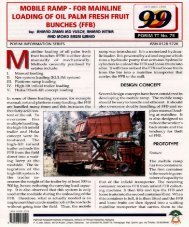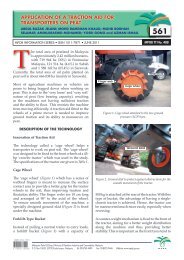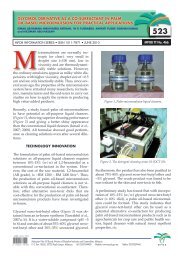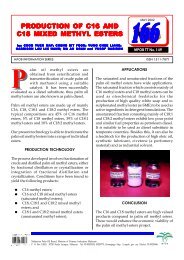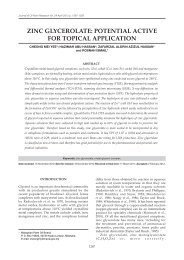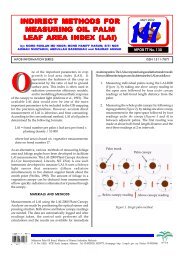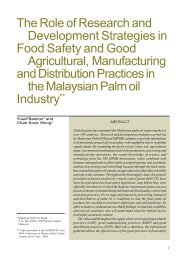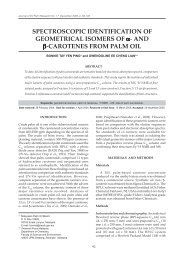(pcm) in gypsum board for building application - PALMOILIS - MPOB
(pcm) in gypsum board for building application - PALMOILIS - MPOB
(pcm) in gypsum board for building application - PALMOILIS - MPOB
You also want an ePaper? Increase the reach of your titles
YUMPU automatically turns print PDFs into web optimized ePapers that Google loves.
Journal of Oil Palm A STUDY Research ON THERMAL Vol. 17 June CHARACTERISTICS 2005, p. 41-46OF<br />
PHASE CHANGE MATERIAL (PCM) IN GYPSUM BOARD FOR BUILDING APPLICATION<br />
A STUDY ON THERMAL CHARACTERISTICS<br />
OF PHASE CHANGE MATERIAL (PCM) IN<br />
GYPSUM BOARD FOR BUILDING<br />
APPLICATION<br />
ROZANNA, D*; SALMIAH, A**; CHUAH, T G*; MEDYAN, R*; THOMAS CHOONG, S Y* and SA’ARI, M*<br />
ABSTRACT<br />
Us<strong>in</strong>g fatty acids as phase change materials (PCMs), it is possible to store a large amount of thermal energy<br />
<strong>in</strong> a small mass and with a narrow temperature transition. Passive solar heat<strong>in</strong>g and cool<strong>in</strong>g can be done by<br />
three methods – simple immersion, direct <strong>in</strong>corporation and encapsulation. This study <strong>in</strong>vestigated the effect<br />
of us<strong>in</strong>g a lauric-stearic acids eutectic mixture at 75.5:24.5 w/w as PCM <strong>in</strong> <strong>gypsum</strong> <strong>board</strong>. The eutectic<br />
mixture had a melt<strong>in</strong>g po<strong>in</strong>t of 34.1ºC and latent heat of 171.1 kJ kg-1 respectively. Gypsum <strong>board</strong>s were<br />
immersed 1 hr <strong>in</strong> PCM and the thermal characteristics be<strong>for</strong>e and after immersion were <strong>in</strong>vestigated. The<br />
12.5 mm <strong>board</strong> absorbed 38.0% PCM and differential scann<strong>in</strong>g calorimetry (DSC) showed that the melt<strong>in</strong>g<br />
po<strong>in</strong>t and latent heat were 34.0ºC and 50.28 kJ kg-1 , respectively. For 6 mm <strong>board</strong>, PCM absorption was<br />
39.2% with the melt<strong>in</strong>g po<strong>in</strong>t of 34.0ºC and the latent heat of 52.87 kJ kg-1 . From the results, the thermal<br />
characteristics of the PCM-<strong>gypsum</strong> <strong>board</strong>s were similar to those of the PCM.<br />
Keywords: eutectic mixtures, fatty acids, latent heat, phase change materials (PCMs), thermal characteristic.<br />
Date received: 9 March 2004; Sent <strong>for</strong> revision: 25 March 2004; Received <strong>in</strong> f<strong>in</strong>al <strong>for</strong>m: 19 October 2004; Accepted: 28 October 2004.<br />
INTRODUCTION<br />
In PCMs, heat is stored as latent heat of fusion <strong>in</strong><br />
phase changes. Latent heat allows a large amount of<br />
energy to be stored <strong>in</strong> a small mass/volume with<br />
the phase transition occurr<strong>in</strong>g at nearly constant<br />
temperature. In a wide diurnal temperature range,<br />
PCM can be used to absorb heat dur<strong>in</strong>g the day and<br />
release it at night. In hot countries where the<br />
temperature is high throughout the day and night,<br />
the concept needs to be slightly modified.<br />
Otherwise, PCM cannot be used effectively. As an<br />
example, a Malaysian terrace house is humid with<br />
temperature reach<strong>in</strong>g 50ºC <strong>in</strong> the roof space dur<strong>in</strong>g<br />
a heat wave (Davis et al., 2003). The hot air heats up<br />
* Department of Chemical and Environmental Eng<strong>in</strong>eer<strong>in</strong>g,<br />
Faculty of Eng<strong>in</strong>eer<strong>in</strong>g, Universiti Putra Malaysia,<br />
43400 UPM Serdang, Selangor,<br />
Malaysia.<br />
E-mail: dewi medyan@yahoo.com<br />
** Malaysian Palm Oil Board,<br />
P. O. Box 10620,<br />
50720 Kuala Lumpur,<br />
Malaysia.<br />
41<br />
the concrete structure which reta<strong>in</strong>s the heat <strong>for</strong> most<br />
of the day. To achieve a com<strong>for</strong>table temperature <strong>in</strong><br />
the build<strong>in</strong>g, the solar heat must be blocked off<br />
possibly by us<strong>in</strong>g PCM as a barrier with an <strong>in</strong>sulator<br />
to prevent heat from enter<strong>in</strong>g the build<strong>in</strong>g.<br />
For a material to be used as PCM, some of the<br />
follow<strong>in</strong>g criteria must be fulfilled: high heat of<br />
fusion, high density, high specific heat, congruent<br />
melt<strong>in</strong>g, small volume change dur<strong>in</strong>g phase change,<br />
chemical stability, non-corrosive, non-poisonous,<br />
non-flammable and non-explosive. F<strong>in</strong>ally, the<br />
availability as well as cost should be taken <strong>in</strong>to<br />
account (Beghi, 1982).<br />
The selection of PCM has recently been directed<br />
towards low melt<strong>in</strong>g organic materials to avoid some<br />
of the problems <strong>in</strong>herent <strong>in</strong> <strong>in</strong>organic materials, such<br />
as supercool<strong>in</strong>g and segregation. Special attention<br />
has been given to fatty acids s<strong>in</strong>ce they are easily<br />
obta<strong>in</strong>ed from renewable sources such as oils/fats<br />
(Feldman et al., 1996).<br />
Fatty acids show solid-liquid transitions with<strong>in</strong><br />
a narrow temperature range. They are superior to<br />
other PCMs <strong>in</strong> some properties such as melt<strong>in</strong>g<br />
congruency, chemical stability, non-toxicity and
JOURNAL OF OIL PALM RESEARCH 17 (JUNE 2005)<br />
melt<strong>in</strong>g temperature range <strong>for</strong> passive solar heat<strong>in</strong>g.<br />
In the liquid phase, these materials have a surface<br />
tension of 20-30 dyne cm -1 which is high enough <strong>for</strong><br />
them to be held <strong>in</strong> the host material structure. These<br />
materials possess elevated latent heats of transition<br />
and high specific heats (1.9-2.1 J g -1 ºC -1 ). They also<br />
exhibit only small volume changes dur<strong>in</strong>g melt<strong>in</strong>g<br />
or solidification (<strong>for</strong> example, melt<strong>in</strong>g dilatation of<br />
0.1-0.2 ml g -1 ). Fatty acids-based PCMs are<br />
chemically and thermally stable and non-toxic with<br />
low corrosion activity, and fast colours because of<br />
the protected carboxyl group (Feldman et al., 1995).<br />
PCM can be used alone or <strong>in</strong> eutectic mixtures<br />
(b<strong>in</strong>ary mixtures that exhibit fixed melt<strong>in</strong>g/<br />
solidification po<strong>in</strong>ts at a certa<strong>in</strong> ratio between the<br />
components and which act as a s<strong>in</strong>gle component).<br />
In passive solar <strong>application</strong>s, three methods are<br />
proposed <strong>for</strong> <strong>in</strong>corporation of a thermal storage<br />
material with<strong>in</strong> the construction element:<br />
encapsulation of the storage material <strong>in</strong> high density<br />
polyethylene pellets mixed <strong>in</strong> with <strong>gypsum</strong> <strong>board</strong><br />
materials, direct <strong>in</strong>corporation and simple<br />
immersion of conventional <strong>board</strong>s <strong>in</strong> molten PCM.<br />
The latter method contributes to the economic<br />
impact of the passive solar wall (Zelba et al., 2003).<br />
In this paper, simple immersion of <strong>gypsum</strong><br />
<strong>board</strong>s <strong>in</strong> a eutectic mixture of lauric-stearic acids<br />
(75.5:24.5 w/w) as PCM is discussed. Gypsum is a<br />
non-metallic m<strong>in</strong>eral, found as a rock composed of<br />
70.1% calcium sulphate and 20.9% water by weight.<br />
In the construction <strong>in</strong>dustry, <strong>gypsum</strong> <strong>board</strong> is widely<br />
used as ceil<strong>in</strong>g, roof and walls. It is considered a<br />
good support<strong>in</strong>g medium <strong>for</strong> PCM s<strong>in</strong>ce<br />
approximately 41% of it is air voids (Rudd, 1993).<br />
Materials<br />
EXPERIMENTAL<br />
The fatty acids used are lauric acid (99% pure)<br />
and stearic acid (98% pure) of commercial grade,<br />
products of Palm-Oleo Sdn Bhd, Malaysia. The<br />
chemicals were used without any purification.<br />
Lauric and stearic acid have melt<strong>in</strong>g po<strong>in</strong>ts of 44ºC<br />
and 69.6ºC, respectively. A eutectic mixture of lauricstearic<br />
acids <strong>in</strong> the weight ratio 75.5:24.5 was<br />
prepared by melt<strong>in</strong>g the acids together at 80ºC (Sari<br />
et al., 2004).<br />
In the construction <strong>in</strong>dustry, <strong>gypsum</strong> <strong>board</strong>s of<br />
thickness 6 or 12.5 mm are frequently used and these<br />
two thickness types were used <strong>in</strong> this study. Gypsum<br />
<strong>board</strong> was prepared by mix<strong>in</strong>g <strong>gypsum</strong> with water<br />
<strong>in</strong> the ratio 1.25:1 and poured <strong>in</strong>to a 20 x 20 x 1.25/<br />
0.6 cm mould. After stiffen<strong>in</strong>g, the <strong>board</strong>s were cut<br />
<strong>in</strong>to 6 x 15 x 1.25/0.6 cm sizes. The physical<br />
properties of the <strong>gypsum</strong> samples be<strong>for</strong>e and after<br />
immersion <strong>in</strong> PCM were tested.<br />
42<br />
Method<br />
The thermal properties of the eutectic mixture of<br />
lauric-stearic acids such as melt<strong>in</strong>g po<strong>in</strong>t,<br />
solidification po<strong>in</strong>t and latent heat, were first<br />
characterized. The <strong>gypsum</strong> <strong>board</strong> samples (6 x 15 x<br />
1.25/0.6 cm) were immersed <strong>for</strong> 1 hr <strong>in</strong> the eutectic<br />
mixture at 60ºC. After immersion, the samples were<br />
taken out, dried and their thermal characteristics<br />
analysed.<br />
DSC Analysis<br />
Differential scann<strong>in</strong>g calorimetry (DSC Perk<strong>in</strong>-<br />
Elmer Thermal Analysis Seri 7) was used to measure<br />
the thermal characteristics of the eutectic mixture and<br />
PCM-<strong>gypsum</strong> <strong>board</strong>s. Samples (2.5-10 mg) were<br />
weighed <strong>in</strong> a sealed alum<strong>in</strong>ium pan. DSC thermal<br />
analysis was per<strong>for</strong>med from –10ºC to +80ºC with a<br />
heat<strong>in</strong>g rate of 5ºC m<strong>in</strong> -1 under a constant stream of<br />
nitrogen at atmospheric pressure. The melt<strong>in</strong>g<br />
temperature of the PCM, T m , corresponded to the<br />
onset temperature obta<strong>in</strong>ed by draw<strong>in</strong>g a l<strong>in</strong>e at the<br />
po<strong>in</strong>t of maximum slope of the lead<strong>in</strong>g edge of the<br />
peak. The latent heat, DH fus , was calculated as the<br />
area under the peak by numerical <strong>in</strong>tegration. In<br />
addition, the melt<strong>in</strong>g or solidification peak<br />
temperatures were def<strong>in</strong>ed as the temperatures of<br />
the po<strong>in</strong>ts from the base l<strong>in</strong>e.<br />
RESULTS AND DISCUSSION<br />
DSC analysis of the eutectic mixture of lauric-stearic<br />
acids (75.5:24.5 w/w) showed a sharp peak with no<br />
secondary peak or hump from –10 to +80ºC. It can<br />
be seen from Figure 1 that the melt<strong>in</strong>g temperature,<br />
latent heat and melt<strong>in</strong>g temperature range of the<br />
eutectic mixture were 34.1ºC, 171.1 J g<br />
á<br />
-1 and 30.1ºC-<br />
42.2ºC, respectively. The melt<strong>in</strong>g po<strong>in</strong>t of the eutectic<br />
mixture was lower than those of the s<strong>in</strong>gle acids.<br />
However, the latent heat was high enough to be<br />
comparable to those of other PCMs, such as salt<br />
hydrates and polyalcohols, which are 100-250 J g-1 .<br />
The thermal characteristics of solidification as<br />
determ<strong>in</strong>ed by DSC are shown <strong>in</strong> Figure 2 – the<br />
solidification po<strong>in</strong>t was 30.9ºC, latent heat 168.0 J g-1 and solidification temperature range 32.7ºC -23.0ºC.<br />
The temperature transitions between melt<strong>in</strong>g and<br />
solidification were 34.1ºC and 30.9ºC, which are<br />
considered close. The solid-liquid phase transition<br />
was reversible, as the heat absorbed as latent heat of<br />
fusion can be released as the heat of solidification<br />
(with a small heat loss).<br />
After immersion <strong>for</strong> 1 hr <strong>in</strong> the eutectic mixture,<br />
the absorption of acids by the <strong>gypsum</strong> <strong>board</strong> did not<br />
exceed 30%. Nikolic et al. (2003) also reported the<br />
absorption not exceed<strong>in</strong>g 30% <strong>for</strong> some fatty acid<br />
esters and a eutectic mixture of palmitic and stearic
A STUDY ON THERMAL CHARACTERISTICS OF PHASE CHANGE MATERIAL (PCM) IN GYPSUM BOARD FOR BUILDING APPLICATION<br />
Figure 1. DSC thermogram of the eutectic mixture of lauric-stearic acids (75.5:24.5 w/w) scanned at 5ºC m<strong>in</strong> -1<br />
(heat<strong>in</strong>g).<br />
Figure 2. DSC thermogram of the eutectic mixture of lauric-stearic acids (75.5:24.5 w/w) scanned at 5ºC m<strong>in</strong> -1<br />
(cool<strong>in</strong>g).<br />
acids <strong>in</strong> the same immersion conditions. Feldman<br />
et al. (1996) reported only 25% absorption of a eutectic<br />
mixture of butyl palmitate-butyl stearate with<br />
immersion at lower than 80ºC. The variation on the<br />
f<strong>in</strong>d<strong>in</strong>gs can be due to different immersion times and<br />
the type of PCMs used. Table 1 shows the amounts<br />
of fatty acids absorbed by the <strong>gypsum</strong> <strong>board</strong>s.<br />
Figures 3 to 6 illustrate the DSC thermograms <strong>for</strong><br />
the 12.5 mm <strong>gypsum</strong> <strong>board</strong> loaded with 27.5% acids<br />
and 6 mm <strong>gypsum</strong> <strong>board</strong> loaded with 28.2% acids<br />
43<br />
<strong>for</strong> heat<strong>in</strong>g and cool<strong>in</strong>g, respectively. The f<strong>in</strong>d<strong>in</strong>gs<br />
are summarized <strong>in</strong> Tables 2 and 3.<br />
From Figures 1 to 6, the thermal characteristics of<br />
the PCM-<strong>gypsum</strong> <strong>board</strong>s were very close to those<br />
of PCM alone. The melt<strong>in</strong>g and freez<strong>in</strong>g curves were<br />
sharp with no secondary peak or hump.<br />
Some physical properties of the <strong>gypsum</strong> <strong>board</strong>s<br />
were also tested to show that the immersion did not<br />
unduly affect their physical characteristics. Indeed,<br />
with the exception of conductivity, which was higher<br />
after immersion <strong>for</strong> better absorption of heat, the
JOURNAL OF OIL PALM RESEARCH 17 (JUNE 2005)<br />
TABLE 1. EUTECTIC MIXTURE ABSORBED BY GYPSUM BOARD (%)<br />
Gypsum <strong>board</strong> Replicate 1 Replicate 2 Replicate 3 Average<br />
(%) (%) (%) (%)<br />
12.5 mm 28.5 27.5 27.4 27.8<br />
6 mm 26.9 28.2 28.0 27.7<br />
Figure 3. DSC thermogram of the 12.5 mm PCM-<strong>gypsum</strong> <strong>board</strong> with load<strong>in</strong>g at 38.0% weight scanned at 5ºC m<strong>in</strong> -1<br />
(heat<strong>in</strong>g).<br />
Figure 4. DSC thermogram of the 12.5 mm PCM-<strong>gypsum</strong> <strong>board</strong> with load<strong>in</strong>g at 38.0% weight scanned at 5ºC m<strong>in</strong> -1<br />
(cool<strong>in</strong>g).<br />
44
A STUDY ON THERMAL CHARACTERISTICS OF PHASE CHANGE MATERIAL (PCM) IN GYPSUM BOARD FOR BUILDING APPLICATION<br />
Figure 5. DSC thermogram of the 6 mm PCM-<strong>gypsum</strong> <strong>board</strong> with load<strong>in</strong>g at 39.2% weight scanned at 5ºC m<strong>in</strong> -1<br />
(heat<strong>in</strong>g).<br />
Figure 6. DSC thermogram of the 6 mm PCM-<strong>gypsum</strong> <strong>board</strong> with load<strong>in</strong>g at 39.2% weight scanned at 5ºC m<strong>in</strong> -1<br />
(cool<strong>in</strong>g).<br />
TABLE 2. THERMAL CHARACTERISTICS OF THE PCM-GYPSUM BOARDS (melt<strong>in</strong>g)<br />
Gypsum Replicate Melt<strong>in</strong>g po<strong>in</strong>t Latent heat Melt<strong>in</strong>g temperature<br />
<strong>board</strong> T m (ºC) ∆H fus (J g -1 ) range (ºC)<br />
12.5 mm 1 34.1 55.96 30.9-42.3<br />
2 34.0 50.28 28.9-41.8<br />
3 33.9 55.68 29.7-41.8<br />
6 mm 1 34.3 46.60 31.6-42.1<br />
2 34.0 52.87 30.0-42.0<br />
3 33.8 55.24 28.6-42.3<br />
45
JOURNAL OF OIL PALM RESEARCH 17 (JUNE 2005)<br />
TABLE 3. THERMAL CHARACTERISTICS OF THE PCM-GYPSUM BOARDS<br />
Gypsum Replicate Melt<strong>in</strong>g po<strong>in</strong>t Latent heat Solidification temperature<br />
<strong>board</strong> T m (ºC) ∆H fus (J g -1 ) range (ºC)<br />
12.5 mm 1 32.4 54.43 34.4-23.7<br />
2 32.0 48.01 33.3-24.0<br />
3 32.2 53.63 33.5-22.0<br />
6 mm 1 32.2 45.36 33.5-24.0<br />
2 31.8 51.06 33.5-23.6<br />
3 32.0 52.93 33.8-23.8<br />
TABLE 4. PHYSICAL PROPERTIES OF GYPSUM BOARDS BEFORE AND AFTER IMMERSION<br />
Gypsum <strong>board</strong> Conductivity at 31ºC Density Shore hardness<br />
(W m -1 K -1 ) (kg m -3 )<br />
Be<strong>for</strong>e After Be<strong>for</strong>e After Be<strong>for</strong>e After<br />
12.5 mm 0.4937 0.5632 957.2 1498.9 85 85<br />
6 mm 0.3871 0.4940 957.8 1447.6 87 86<br />
PCM did not decrease <strong>in</strong> hardness. The different<br />
thickness of <strong>gypsum</strong> also did not affect the<br />
absorption of acids and the thermal characteristics.<br />
Table 4 shows some physical properties of the<br />
<strong>gypsum</strong> <strong>board</strong>s be<strong>for</strong>e and after immersion.<br />
CONCLUSION<br />
The eutectic mixture of lauric-stearic acids (75.5:24.5<br />
w/w) had a melt<strong>in</strong>g po<strong>in</strong>t of 34.1ºC, heat of fusion<br />
of 171.1 J g -1 and close temperature transition. When<br />
impregnated <strong>in</strong> <strong>gypsum</strong> <strong>board</strong>s, the thermal<br />
characteristics of the mixture were practically<br />
unchanged, with one sharp peak and no additional<br />
peak or hump. Indeed, the immersion did not affect<br />
the physical characteristics of the <strong>gypsum</strong> <strong>board</strong>s.<br />
For further study, it is recommended that a suitable<br />
<strong>in</strong>sulator be attached to the PCM-<strong>gypsum</strong> <strong>board</strong> and<br />
an accelerated thermal cycle test run to detect any<br />
thermal behaviour change (if any) <strong>in</strong> long-term use.<br />
ACKNOWLEDGEMENT<br />
The authors would like to thank the Advanced<br />
Oleochemical Technology Division (AOTD), <strong>MPOB</strong>,<br />
<strong>for</strong> its support of this work.<br />
REFERENCES<br />
BEGHI, G (1982). Thermal energy storage. D. Reidel<br />
Publisher Company. Dordrecht, Holland.<br />
46<br />
DAVIS, P; NORDIN, N A; GHAZALI, M and<br />
REIMAN, G (2003). Thermal com<strong>for</strong>t <strong>for</strong> Malaysia,<br />
Ch<strong>in</strong>a and Arab countries. Bulet<strong>in</strong> Ingenieur. Vol 19.<br />
FELDMAN, D; BANU, D and HAWES, D (1996).<br />
DSC analysis <strong>for</strong> the evaluation of an energy stor<strong>in</strong>g<br />
wall<strong>board</strong>. Thermochimica Acta, 272: 243-251.<br />
FELDMAN, D; BANU, D and HAWES, D (1995).<br />
Low cha<strong>in</strong> esters of stearic acids as phase change<br />
materials <strong>for</strong> thermal energy storage <strong>in</strong> build<strong>in</strong>g.<br />
Solar Energy Materials and Solar Cells, 36: 311-322.<br />
NIKOLIC, R; MARINOVIC-CINCOVIC, M;<br />
GADZURIC, S and ZSIGRAI, I J (2003). New<br />
materials Á<strong>for</strong><br />
solar thermal storage – solid/liquid Á<br />
transitions <strong>in</strong> fatty acid ester. Solar Energy Materials<br />
and Solar Cells, 79: 285-292.<br />
RUDD, A F (1993). Phase change material wall<strong>board</strong><br />
<strong>for</strong> distributed thermal storage <strong>in</strong> build<strong>in</strong>gs.<br />
ASHRAE Transaction, 99. Part 2, 3724.<br />
SARI, A; SARI, H and ONAL, A (2004). Thermal<br />
properties and thermal reliability of eutectic mixtures<br />
of some fatty acids as latent heat storage materials.<br />
Energy Conversion and Management, 45: 365–376.<br />
ZELBA, B; MARIN, J; CABEZA, L F and MEHLING,<br />
H (2003). Review on thermal energy storage with<br />
phase change; materials, heat transfer analysis and<br />
<strong>application</strong>. Applied Thermal Eng<strong>in</strong>eer<strong>in</strong>g, 23: 251-183.



